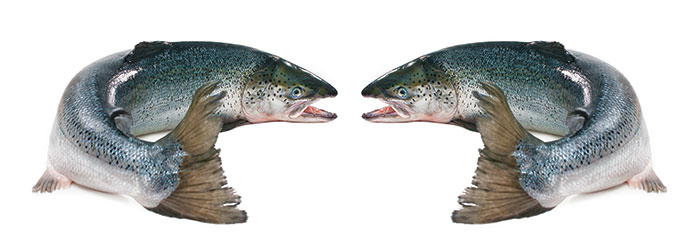Careful observations define empirical science. When “modern science” experts teach us about nature, we expect to learn about how our world works.
How does snow form and fall? How do birds fly? How do squirrels jump? How do fish swim? The answers require us to look with exacting care and to record what we see with exacting accuracy. Objective observations, carefully reported, qualify such studies as “empirical science,” i.e., seeing the natural world in the present.
For example, consider how Dr. Robert Behnke, a Colorado ichthyology professor, reports the upstream-swimming movements made by salmonids, finfish from the Salmonidae family featuring salmon, trout, and char:
Salmonid fishes have long been admired for their elegant form and the grace with which they are able to swim through the water and leap over waterfalls. All salmonids share the same basic elongated, streamlined shape. Their power is supplied from compact, highly organized muscles that extend the entire length of the body.1
As 21st-century readers, we anticipate and analyze these kinds of empirical descriptions of animal anatomy and behavior. They match our expectations of modern science. Likewise, we sometimes assume that the careful viewing of creatures in the wild and descriptive reporting of such data will improve upon the primitive understanding of “prescientific” societies.
But there is something fishy about that kind of stereotypical thinking. To illustrate, consider the report of British scientist Gerald de Barry, documenting in detail how salmon catapult themselves as they swim upstream in Irish rivers:
This is how the salmon contrives to leap. When the fish of this species [are] swimming, as is natural, against the course of the water…[and] come to some apparently insurmountable obstacle, they twist their tails round towards their mouths. Sometimes, in order to give more power to their leap, they go so far as to put their tails right in their mouths. Then with a great snap, like the sudden straightening of a bough which has long been held bent, they jerk themselves out of this circular position and so leap from the lower pool to the one above, to the great astonishment of anyone who happens to be watching.2
Wow! That description reports careful observations!
That’s “modern science”—except it’s not modern at all—it was written about 800 years ago, at least a generation before the Battle of Largs ended the Viking Era in the British Isles.
Are these modern-sounding observations surprising? They shouldn’t be.
Mankind is not evolving. Adam’s race was created with powerful abilities to think rationally, to watch animals in the wild, to examine plants that grow, and to interpret cause-and-effect relationships that drive natural processes. Although earlier generations lacked today’s technology, they were far from primitive dummies incapable of empirical scientific observations. Adam, the first man, became the original, real empirical scientist when God tasked him with the taxonomic labeling of all of the original animals that dwelt in Eden (Genesis 2:19-20). God made Adam’s race keen-eyed and “smart from the start”—but when we forget our Creator, we play the fool (Psalm 14:1).
Though some imagine brute cave men as our ancestors, Genesis reports the real history of mankind. Thankfully, humans were wonderfully created with intelligent minds and choice-making wills, capable of recognizing and receiving (or rejecting) factual information.
Accordingly, as creationists, we should intelligently study the empirical facts about salmonids (and all of nature), and we should also affirm and clarify God’s revealed truth about our own origins in our role as “fishers of men.”3
References
- Behnke, R. J. and J. R. Tomelleri. 2002. Trout and Salmon of North America. New York: Simon & Schuster, 7.
- de Barry, G. 2004. Gerald of Wales: The Description of Wales, Book II. L. Thorpe, trans. London: Penguin Books, 173 (quoting from Gerald’s The History and Topography of Ireland, Book II, chapter 42). Gerald died in 1223. For historical perspective, consider that Gerald was an F3 descendant (i.e., great-grandson) of Rhys ap Tewdwr, a political competitor (during 1081) of the famous Viking king William the Conqueror.
- Matthew 4:19.
* Dr. Johnson is Associate Professor of Apologetics and Chief Academic Officer at the Institute for Creation Research.





